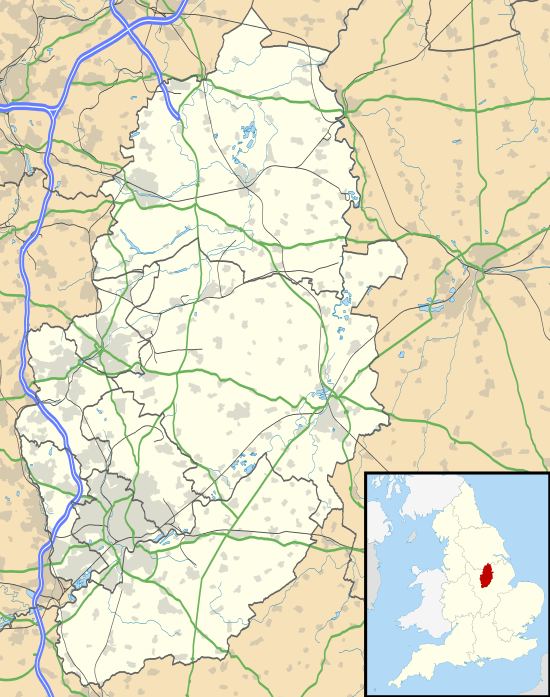Church of St Chad, Pleasley Vale
The Church of St Chad (also known as St Chad's) is on Church Lane, Pleasley Vale, Nottinghamshire, England. It is an active Church of England parish church in the deanery of Mansfield, the Archdeaconry of Newark, and the Southwell and Nottingham diocese. Its benefice has three churches, Church of St Edmund, Mansfield Woodhouse is the main parish church, St Chad's and the Community Church on the Peafield Lane Estate are the other two.[1] The church is recorded in the National Heritage List for England as a designated Grade II listed building.[2]
| Church of St Chad, Pleasley Vale | |
|---|---|
.jpg) Church of St Chad, Pleasley Vale, from Church Lane | |
 Church of St Chad, Pleasley Vale Location in Nottinghamshire | |
| OS grid reference | SK 52697 65081 |
| Location | Church Lane, Pleasley Vale, Nottinghamshire |
| Country | England |
| Denomination | Church of England |
| Churchmanship | Central |
| Website | http://www.stuffynwood.com/st_chads.html |
| History | |
| Status | Parish church |
| Founded | 1876 |
| Founder(s) | Joseph Paget |
| Dedication | St Chad |
| Dedicated | 1876 |
| Architecture | |
| Functional status | Active |
| Heritage designation | Grade II listed |
| Designated | 22 October 1986 |
| Architectural type | Church |
| Style | Gothic |
| Specifications | |
| Materials | Brick and stone, slate roof |
| Administration | |
| Parish | Mansfield Woodhouse |
| Deanery | Mansfield |
| Archdeaconry | Newark |
| Diocese | Southwell and Nottingham |
| Province | York |
| Clergy | |
| Vicar(s) | Rev Allan Scrivener |
History
St Chad's was built by Joseph Paget after he inherited his parent's estate and consequently became a senior partner in nearby Pleasley Vale Mills. In 1876, deciding that his household and mill workers needed a church, a chapel was built overlooking the vale, on the Derbyshire side of the River Meden. The chapel was built of timber, painted white, by Cox & Sons of London. In 1880, it is said that after the vicar, Dr Quilter, objected to his daughter's marriage, Joseph Paget had the church taken down and rebuilt just over the River Meden boundary in Nottinghamshire, thus moving it from the Diocese of Lichfield to the Diocese of Southwell and Nottingham. The church was reconstructed in brick and stone, with a bell tower and lead roof.[3]
Organ
The organ dates from 1880 by Lloyd & Co of Nottingham.
Gallery
.jpg) Church of St Chad, Church Lane, Pleasley Vale
Church of St Chad, Church Lane, Pleasley Vale.jpg) Church of St Chad, Church Lane, Pleasley Vale
Church of St Chad, Church Lane, Pleasley Vale.jpg) Church of St Chad, Church Lane, Pleasley Vale
Church of St Chad, Church Lane, Pleasley Vale
References
- Pleasley Vale: St Chad, Church of England, retrieved 28 December 2017
- Historic England. "Church of St Chad, Church Lane (1251819)". National Heritage List for England. Retrieved 28 December 2017.
- "Church History Project, Diocese of Southwell and Nottingham, History, Pleasley Vale". The University of Nottingham. Retrieved 28 December 2017.